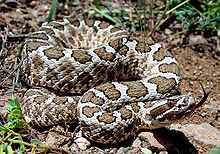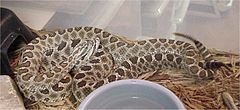- Sistrurus catenatus edwardsii
-
Sistrurus catenatus edwardsii 
Scientific classification Kingdom: Animalia Phylum: Chordata Subphylum: Vertebrata Class: Reptilia Order: Squamata Suborder: Serpentes Family: Viperidae Subfamily: Crotalinae Genus: Sistrurus Species: S. catenatus Subspecies: S. c. edwardsii Trinomial name Sistrurus catenatus edwardsii
(Baird & Girard, 1853)Synonyms - Crotalophorus Edwardsii - Baird & Girard, 1853
- C[rotalus]. (Crotalophorus) miliarius var. Edwardsii - Jan, 1863
- Caudisoma edwardsii - Yarrow, 1875
- [Sistrurus miliarius] Var. edwardsii - Garman, 1884
- Crotalophorus catenatus edwardsii - Cope, 1892
- Sistrurus catenatus edwardsii - Stejneger, 1895
- Sistrurus edwardsii - Cockerell, 1896
- Sistrurus catenatus var. edwardsii - Ditmars, 1907
- Sistrurus catenatus edwardsi - Gloyd, 1955
- Crotalus (Sistrurus) catenatus edwardsi - Hoge, 1966[1]
Sistrurus catenatus edwardsii is a venomous snake pitviper subspecies[5] found in the southwestern United States and northern Mexico. In places its range overlaps that of S. c. tergeminus) and intergrading of the two subspecies is not unknown.
Contents
Description
This subspecies is more slender and smaller than S. c. tergeminus, reaching a maximum length of 53 cm.[2]
The color pattern consists of a light gray or white base color, with dark gray or gray-brown blotches. They have a distinctive, dark stripe that runs along the side of the head which passes over the eye. Their rattles are significantly higher pitched than those of larger species of rattlesnake, sometimes giving them the nickname buzztail.
Compared to S. c. tergeminus, it is paler in color and its belly is nearly white. Midbody, it has 23 rows of dorsal scales instead of 25, as well as fewer ventral scales and dorsal blotches.[3]
Geographic range
Found in the United States extreme southeastern Arizona, central and southern New Mexico, western Texas about as far north and east as the Colorado River, in the Rio Grande Valley, in many of the Gulf Coast counties about as far north as Brazoria, and on several barrier islands including North Padre Island, Matagorda Island and San José Island. In addition, isolated populations have been reported in northeastern Mexico.[3][6][7] The type locality is listed as "Tamaulipas ... S. Bank of Rio Grande ... Sonora."[1]
Habitat
Primarily found in rocky, semi-arid and arid areas. According to Conant (1975), it is mostly found in desert grasslands.[2]
Behavior
They are primarily nocturnal, especially during the summer months when it is too hot for them to be active, but they will sometimes be found out sunning themselves.
Feeding
Their diet consists primarily of rodents, lizards and frogs.
Venom
Drop for drop, Massasauga venom is more potent than that of many larger species of rattlesnake, but due to the lower yield (the amount it is capable of delivering in a single bite) its potential for harm is greatly reduced. They are not considered to be deadly, but the venom is a powerful hemotoxin which can cause swelling, necrosis, and severe pain. Medical treatment should be sought immediately for any venomous snake bite. The antivenin CroFab, while not type specific, can be used to treat severe envenomations from Massasauga rattlesnakes.
Conservation status
The Desert Massasauga is listed as a species of concern in Colorado, due to its limited range in the state, and it is protected by Arizona state law. It is listed as a sensitive species by the United States Forest Service.
See also
- List of crotaline species and subspecies
- Crotalinae by common name
- Crotalinae by taxonomic synonyms
- Snakebite
References
- ^ a b McDiarmid RW, Campbell JA, Touré T. 1999. Snake Species of the World: A Taxonomic and Geographic Reference, vol. 1. Herpetologists' League. 511 pp. ISBN 1-893777-00-6 (series). ISBN 1-893777-01-4 (volume).
- ^ a b c Conant R. 1975. A Field Guide to Reptiles and Amphibians of Eastern and Central North America. Second Edition. First published in 1958. Houghton Mifflin Company Boston. 429 pp. 48 plates. ISBN 0-395-19979-4. ISBN 0-395-19979-8 (pbk.).
- ^ a b c Wright AH, Wright AA. 1957. Handbook of Snakes. Comstock Publishing Associates. (7th printing, 1985). 1105 pp. ISBN 0-8014-0463-0.
- ^ Ditmars RL. 1933. Reptiles of the World. Revised Edition. The MacMillan Company. 329 pp. 89 plates.
- ^ "Sistrurus catenatus edwardsii". Integrated Taxonomic Information System. http://www.itis.gov/servlet/SingleRpt/SingleRpt?search_topic=TSN&search_value=209511. Retrieved 31 January 2007.
- ^ Klauber LM. 1997. Rattlesnakes: Their Habitats, Life Histories, and Influence on Mankind. Second Edition. First published in 1956, 1972. University of California Press, Berkeley. ISBN 0-520-21056-5.
- ^ Campbell JA, Lamar WW. 2004. The Venomous Reptiles of the Western Hemisphere. Comstock Publishing Associates, Ithaca and London. 870 pp. 1500 plates. ISBN 0-8014-4141-2.
Further reading
- Mackessy SP. 2005. Desert Massasauga Rattlesnake (Sistrurus catenatus edwardsii): A Technical Conservation Assessment. USDA Forest Service. PDF at USDA Species Conservation Project. Accessed 31 January 2007.
External links
- Sistrurus catenatus at the Reptarium.cz Reptile Database. Accessed 25 August 2007.
- Sistrurus catenatus at Herps of Texas. Accessed 31 January 2007.
- Sistrurus catenatus (edwardsii) at Arizona Parc. Accessed 25 August 2007.
- Sistrurus catenatus edwardsii at California Reptiles and Amphibians. Accessed 25 August 2007.
Categories:- Crotalinae
- Fauna of the Southwestern United States
- Fauna of Northern Mexico
- Fauna of the U.S. Rio Grande Valleys
Wikimedia Foundation. 2010.

